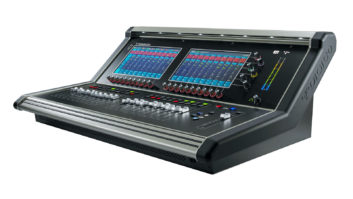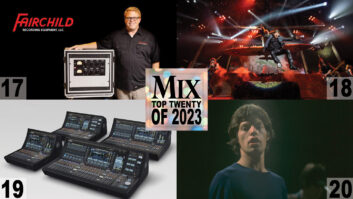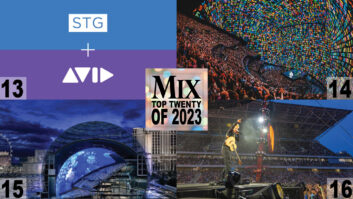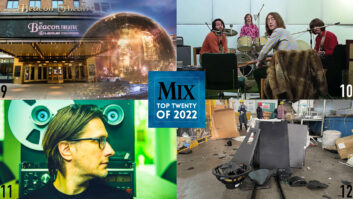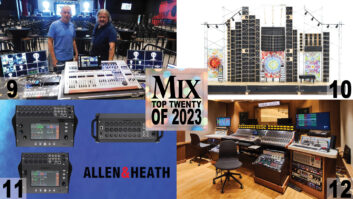The Rock and Roll Hall of Fame Ceremony returned to the West Coast for the first time in 20 years this April, to induct a new class of musicians and industry icons in a nearly 5-hour evening of music and merriment at Los Angeles’ Nokia Theatre. The class of 2013—Public Enemy, Rush, Heart, Randy Newman, Donna Summer, Albert King, Quincy Jones and Lou Adler—were honored by a who’s who of music past and present. For the 13th year, Firehouse Productions handled the audio portion of the show, with Mark Dittmar spearheading the onsite crew comprised of Production Mixer Barry Warrick, Music Mixer Ron Reaves (on a DiGiCo SD7) and Mike Parker handling monitors (SD7).
The show has grown exponentially over the years into what Dittmar calls ‘fast and stupid.’ “And I don’t mean that in a derogatory way,” he laughs. “It’s just that this is the sort of show that keeps growing and giving and growing and giving, and they will never get smaller. There’s so much more desire for content, and there’s a lot more figuring it out on-site. Ten years ago you would spend a huge amount of prep time. Now you fly in and the producer’s like, “Oh, I just added a band.’ Last year they added Green Day, literally two days before the show and we’d already loaded in. We don’t get to say, ‘I’m sorry you didn’t tell us that three weeks ago, we can’t do it.’ You say, ‘OK, we have an hour to set them up.’ You look at what we do routinely now, and if you had asked us to do it 10 years ago, we would have freaked out. We simply didn’t have the tools or the technology to accomplish it. Two years ago we outgrew our Yamaha PM1Ds at FOH and in monitor world because the show kept adding inputs to the point that our only choice in inventory were the DiGiCo SD7s, and it was a logical move for doing these shows. The pace has become very, very fast and we have a great team and great tools in place now that can get the job done easily.”
The show’s drive system is all on fiber optics now with the SD7s and a trio of SD racks networked via Optocore. “Everything is digital, front to back,” Dittmar adds. “The signal path from the input of the SD7 into the amplifier is digital the entire way. You couldn’t easily accomplish that 10 years ago; we would’ve run out of horsepower with the consoles. Several yeas ago, we thought that we’d probably never fill a 96-input desk, and then we filled a 96-input desk… and more. Now that these things can do hundreds of inputs, the question is, ‘how much can a guy like Ron mix?’ You know, where does your brain give out and say, ‘I can’t find the fifteenth snare drum?!’ We’re doing things very powerful and very fast now, and a key component is the SD7, which allows us to do these shows. The SD7 is powerful and you can put a lot of inputs and outputs into it. Once you’re into an SD7, you no longer need to think about the layout. We just go very, very large with the splits, we give the mixers everything instead of having to repatch in the middle of the show. Parker and Ron don’t have to have a conversation about what they want to see where. We simply send everything to everyone and it’s very easy for them to deal with.”
“The challenge for me on a show like this, where I have a house band and artists walking on and off—as compared to one that’s a bit more ordered like the Grammys, where you have 20 separate bands and 20 different snapshots—is that you have to be a bit more flexible here because it’s all going to change… sometimes multiple times. This is an outstanding band, with some of the top session players, who’ve played on tons of hit records: drummers Steve Ferrone and Jim Keltner, bassist Will Lee, guitarists Waddy Wachtel and Ray Parker Junior, Greg Phillinganes on keys under the direction of Paul Shaffer… it sounds amazing! But for example, on day one of rehearsals, we were on version 10 of our input list. And it changed even more before we took the stage.”
“I’m using my basic Grammy template file because it’s a good starting point for music,” Reaves continues, “and I can just switch the inputs around from there. I’m landing about 112 inputs for the music performance. I do a lot of pre-dialing and I use a lot of presets on this desk, which enables us to go very fast, which is very important for doing TV. And as long as I have plenty of faders, I’m good. And that’s the beauty of the SD7. I can make it as big as I need it to be and can have 256 faders if I need them. I can put everything in the entire show in the console and have it there all night long. And no matter what anyone calls for at the last minute, it’s there. That’s why this is the perfect tool for jobs like this. You can build yourself a giant console so to speak, in terms of layers, and have everything right at your fingertips. These shows keep getting bigger and bigger because we keep pulling it off, but it would never have fitted on the consoles we were using previously. This is the perfect example of how the hardware helped fix the problem.”
At monitor world, it was only Mike Parker’s second time on an SD7, although he’d mixed numerous times on SD10 for events ranging from the Grammys to the Video Music Awards. He found the console’s updated software features exceptionally powerful in managing approximately 130 inputs and 84 outputs for the show.
“The DiGiCo platform is so versatile you can layout any show they throw at you and it can handle it,” he offers. “Not only does it sound good, but it’s probably the most advanced live mixing console in use today. I love the functionality and how you can route things… its quick, easy and very helpful. It enables me to sketch out the console in rehearsals and start dialing up the EQ.
“Monitors are in a critical place for shows like this,” Parker adds. “If the artist is happy with their monitors, chances are you’re gonna get a better performance. But it requires everyone: that means the house mix is good, the crowd reacts and the artist reacts off the crowd… it’s a loop. It creates a great energy that is not seen, but felt. When the monitors and house couple together it’s called a ‘lock’—when everything locks together. I’ve witnessed it several times and it’s magic.”
“This is one of my favorite shows,” Dittmar muses. “I’ve been doing this show longer than anything else in my career and it’s a night of amazing talent. The house band is incredible and you’re getting to hear your favorite bands growing up. Go on YouTube and watch Prince doing “While My Guitar Gently Weeps” from the ceremony several years ago… everyone’s jaw was just on the floor, including Eric Clapton’s!
“When we do large shows like this, I like having the cool tools like the DiGiCos. I like pushing the technological barriers and having the slick setup. But we also like when they work and the SD7s have been flawless for us. We also had a pair of them on the Tony Awards and not only do you have an immensely powerful platform, but you also have the reliability and that makes them very viable. They’re certainly the most popular desk right now, too!”
Pictured LtoR: Production Mixer Barry Warrick, FOH Tech Michael Bove, Music Mixer Ron Reaves and Production manager Mark Dittmar.

